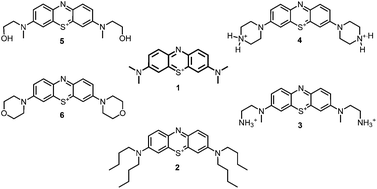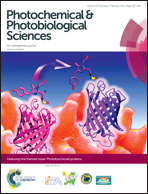A novel set of symmetric methylene blue derivatives exhibits effective bacteria photokilling – a structure–response study†
Abstract
This study focuses on the structure–response relationship of symmetrically substituted phenothiazinium dyes. Four hydrophilic derivatives with the ability of additional hydrogen bonding (5, 6) or additional electrostatic interaction (3, 4) were synthesized, photophysically characterized and compared to the parent compound methylene blue (MB, 1) and a lipophilic derivative (2) without additional coordination sites. Derivative 5 was most effective against Gram-positive Staphylococcus aureus and Gram-negative Escherichia coli reaching a maximum photodynamic efficacy of >5log10 steps (≥99.999%) of bacteria killing in 10 minutes (5 μM, 30 J cm−2) without inherent dark toxicity after one single treatment with the incoherent light source PDT1200 (λmax = 660 nm, 50 mW cm−2). Interestingly, one derivative with two additional primary positive charges (3) showed selective killing of Escherichia coli (5 μM, 30 J cm−2, 4log10 steps inactivation (≥99.99%)) and no antimicrobial effect on Staphylococcus aureus. This might allow the development of a new generation of photosensitizers with higher antimicrobial efficacy and selectivity for future applications.


 Please wait while we load your content...
Please wait while we load your content...